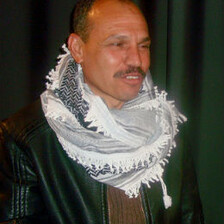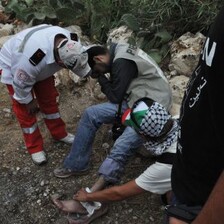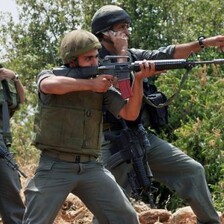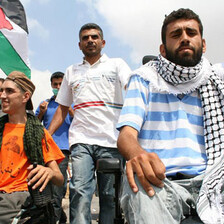Beit Hanoun, Gaza Strip 29 January 2010
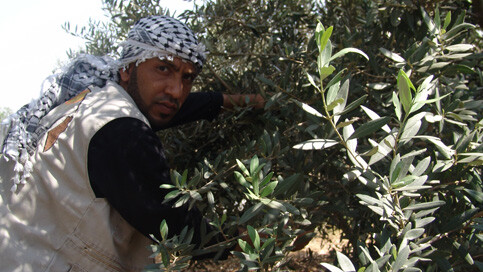
Saber Zanin volunteering in an orchard. (Beit Hanoun Local Initiative)
The Israeli military recently dropped hundreds of leaflets warning Palestinian residents from the village of Beit Hanoun in the northern Gaza Strip not to travel within 300 meters of the border — the distance of Israel’s so-called “buffer zone.” In response, local activists marched to and nonviolently demonstrated inside the “buffer zone” against the illegal action. The Electronic Intifada contributor Jody McIntyre recently spoke with demonstration organizer Saber Zanin.
Jody McIntyre: Can you tell us about yourself?
Saber Zanin: My name is Saber Zanin. I am 31 years old, living in Beit Lahiya, in the northern Gaza Strip. I am a Palestinian who loves life, peace, justice and equal rights for all.
I come from a poor family, around 20 of us in all, from Beit Hanoun. In November 2006, our house, the house I lived in my whole life, was completely destroyed by Israeli air strikes, and then by a tank which came to finish the job. We don’t know why they chose to target our home, but this is an example of the collective punishment we face living in Gaza.
I had the idea to create a group of volunteers, to work together in the local community, to resist Israel’s occupation through nonviolent methods, and to encourage others to do the same. In September 2007, the “Local Initiative” was formed. Rather than relying on governmental institutions or foreign agencies, we work in a personal capacity, and rely on ourselves for everything we need. Altogether the group now consists of around 60 young men and women, from 17-35 years of age, and although we have no political affiliation, we all agree on socialist principles of helping those most in need, and on each individual’s freedom to express their own views.
The group works with all sections of society: women, children, people with disabilities and teenagers. In particular, we give priority to the farmers and residents working and living in the so-called “buffer zone.” As a group, we visit the residents and offer them aid brought by charities to Gaza (although this is small in amount, and limited in effect) for nothing in return, and we accompany the farmers who continue to work on their land, despite regularly being shot at by the Israeli military for doing so. We also work with the young kids in their area, taking them presents, playing games with them and making parties for them, as well as practicalities such as not going out onto the street in certain areas.
The people living in the “buffer zone” are the foundation of the Local Initiative. If there are any farmers who want help working on their land, we will go to help them. We have also organized protests against Israel’s wall in the occupied West Bank and the “buffer zone.”
We are always looking for ways to encourage others to join us in our popular resistance against the occupation, and as part of this we try to teach the local community about the human rights they possess: the right to freedom of expression, the right to live freely, the right to an education, to work, to health care, and to a home. We want people to know about their rights so that when they are taken away from them, they will fight for them.
JM: As someone who used to participate in armed resistance against the occupation, what made you adopt nonviolent resistance?
SZ: Any occupied people have the right to resist, and Palestinians are occupied by the Israelis. It is our fundamental right to resist against this occupation. I used to participate in armed resistance, but armed resistance isn’t everything. I am convinced that popular resistance, and protesting against the occupation through nonviolent methods, can actually achieve more than armed resistance, by gaining the sympathy and support for our struggle from people around the world. When we go to protest against Israel’s wall in the occupied West Bank, as they do in the villages of Bilin and Nilin, and now here in Beit Hanoun in Gaza as well, we have international activists marching with us, and the whole world is watching. Our demonstrations are nonviolent, so the Israeli army has no excuse to shoot at us and to kill us. I believe that this is one of the noblest ways of protesting against the occupation.
Last week, the Israeli military dropped hundreds of leaflets near the “buffer zone,” instructing residents not to go within 300 meters of the border. We reject this illegal de facto land grab, and in response organized a march to the “buffer zone” on Monday [11 January]. The march was under the slogan: “With popular resistance, we challenge the decisions of the Israeli occupiers.” We protested against the occupation through nonviolent means.
We will now be marching to the “buffer zone” every Monday. We will not be intimidated by the Israeli army’s threat, and we will never give up until the occupation is over.
JM: How can people living abroad support your struggle?
SZ: As we move into the new year, the Local Initiative is in urgent need of funds, in order to continue supporting the families living in the “buffer zone,” and to purchase materials in order to document the ongoing crimes of the Israeli occupation forces.
We truly hope that activists from around the world will support us. They could also write in the media against Israel’s crimes, organize demonstrations outside the Israeli embassy — some governments have even expelled the Israeli ambassador! In the UK an arrest warrant was issued for Tzipi Livni for the war crimes she committed against the people of Gaza, and this should serve as an inspiration for others to follow. Together, we can end this occupation.
Jody McIntyre is a journalist from the United Kingdom, currently living in Beit Lahiya in the occupied Gaza Strip. Jody has cerebral palsy, and travels in a wheelchair. He writes a blog for Ctrl.Alt.Shift, entitled “Life on Wheels,” which can be found at www.ctrlaltshift.co.uk. To contact Jody, and for more information about the Local Initiative, email jody.mcintyre AT gmail DOT com.
